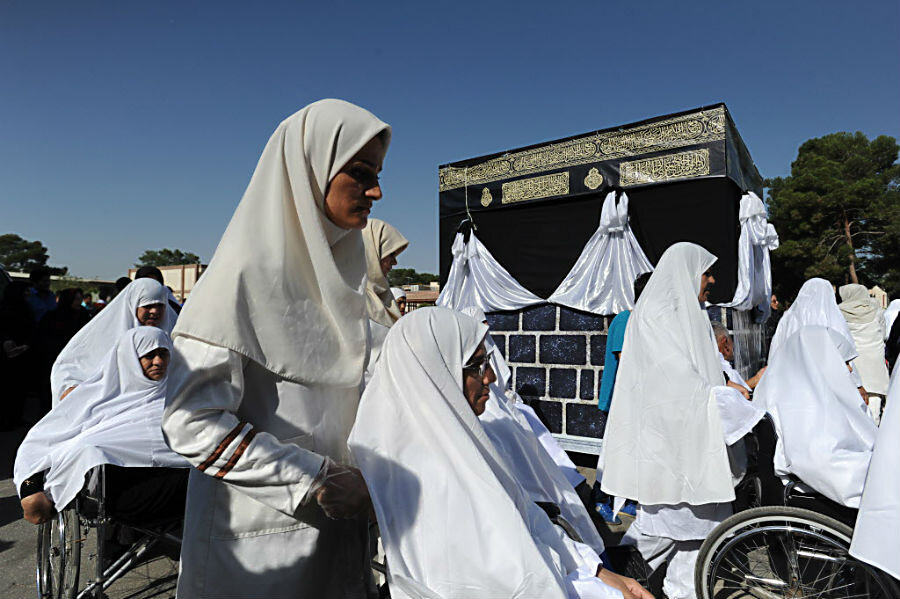Iranians mark Feast of Sacrifice as day of charity rooted in history
Loading...
| Tehran, Iran
Marking one of Islam’s holiest days, Fatameh Saee left a communal abattoir with her family, a freshly butchered leg of a lamb wrapped neatly in plastic, and her thoughts on what Eid al-Adha, or Feast of the Sacrifice, means to her.
“This Eid is very significant for me, it’s important for my religion,” says Ms. Saee. “It is all rooted in history, and the fact of Abraham’s sacrifice,” she says.
In the story common to Christians, Muslims, and Jews, God tests the patriarch’s faith. In Muslim tradition God orders him to sacrifice his beloved son Ishmael.
That epic test is being marked across the Islamic world. In Tehran that means celebrating hope and charity – and the slaughter of thousands of sheep, a traditional act to commemorate God’s decision, when he saw Abraham’s willingness to give up Ishmael, to allow a ram to be killed instead.
That the legendary event is held to have taken place centuries ago “means the eternity of Islam, and its timelessness,” says Saee, who comes back year after year for the communal observance. This year she donated one sheep and was buying a token portion. Tradition holds that the sacrificial sheep is divided into three, with even portions to the family, relatives and neighbors, and the poor.
As dawn broke south of Tehran on Monday, the sun lit up pens of sheep ready for slaughter at the Kahrizak Charity Foundation, a sprawling complex for the disabled and elderly with an abattoir built-in to host the annual ritual.
“It is a holiday rooted in our principles and values, a holiday when people offer their donations,” says Mohammad Reza Sufinejad, director of the private foundation, as squads of butchers in the abattoir nearby dispatched, skinned, and prepared for distribution hundreds of donated sheep.
Day of charity
Some 2,000 sheep were donated this year to this center alone, with one-quarter slaughtered on site and the rest sent to the needy elsewhere. In Persian, the holiday is called Eid-e Ghorban.
“This is a day of charity,” says Mr. Sufinejad, noting that the volume of meat will help feed the complex’s 1,750 residents for two to three months.
On the Eid, the rate at which sheep are slaughtered jumps 10-fold in Tehran, from a daily average of 5,700 sheep up to 60,000, according to official statistics for 2014. That year nearly 9.2 million sheep were butchered nationwide. Little goes to waste: even the heads and feet are used in a rich delicacy called kalle pache.
Yet the Eid tradition has drawn some controversy, with animal-rights activists on social media calling for Iranians to plant trees instead. Some responded online, asking whether the critics did not ever like eating lamb or meat kabob, staples of Iranian cooking.
Noting the debate in October 2013, the hard-line website Raja News asked a cleric for a religious interpretation, about whether it was better to plant trees or to kill sheep for the Eid.
Planting trees was also a virtue, but “God’s verdict is not changeable,” said Hojj. Vahid Babadaei, head of Applied Teaching and Preaching for the Tehran provincial seminary. Sacrificing sheep “is a divine tradition which has many positive outcomes.”
Feeling 'God's presence'
Such concerns were not part of the feel-good factor this Eid at the south Tehran charity foundation, which put on an open house for donors – many of them well-heeled north Tehranis – selling handicrafts made by residents and showing their activities.
The foundation mounts events on each religious day of the Shiite calendar, and on Monday dozens of children and others in a wheelchair procession circled a makeshift Kaaba, with a faux black stone edifice, to reenact one of the events of the five-day Hajj pilgrimage in Saudi Arabia that began this week.
One mother fussed over her wheelchair-bound son, as she put on his religious skullcap; another dispensed a hug to her daughter, who beamed. Charity staffers say donors feel good when they give money or their time, with volunteers doing everything from providing daily baths to helping maintain a garden. One volunteer who lives in the Netherlands brings seeds.
“Our people believe they can feel God’s presence in such places,” says Maryam Abbasnejad, a staff member of the Kahrizak Charity Foundation, which relies on private donors.
“Despite economic problems and inflation, our people are so generous,” says Ms. Abbasnejad. “Even with 1,750 people here, we never have a problem with food or feeding them breakfast…. A person who steps here will feel God’s presence and come back next year.”








